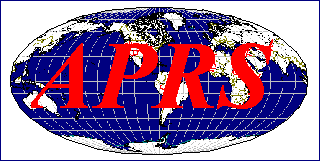 Automatic Position Reporting System
Automatic Position Reporting System

This Plan was updated on 10 April 2005
This digipeater plan for Maryland and Virginia is inspired by all the
new recommendations for all digipeaters in North America in the
New n-N Paradigm. This major change
will fix the congestion presently overloading the APRS network and making it
un-reliable. With the reduced QRM by a factor of 3 to 5, the reliablity and
capacity of the network will drastically improve.
National New n-N PARADIGM SUMMARY:
See: The KPC-3+ Late 8.2 and all 8.3 versions Recommended Settings in MD and VA
USER RECOMMENDATIONS ARE SIMPLIFIED: The best path is simply WIDE2-2. It will
work everyhwere. In wide-open areas such as western Maryland and Virginia, WIDE3-3 may be OK.
MDn-N and VAn-N will also work to support state wide communications without QRM across
borders.. For MDn-N or VAn-N use an N based on your location and who you need to hit,
probably 3, but may be higher in the far corners of the state.
ABUSIVE WIDEn-N FILTERING: This New n-N Paradigm became possible when we
realized that the ALIAS list in the KPC-3 digipeaters can be used also as a TRAP
for large values of N originated in the local area. This is
accomplished by setting the UIDIGI parameter to trap WIDE4-4, 5-5, 6-6 and 7-7.
They will be digipeated once and then swapped with the DIGI callsign.
Thus preventing further propagation.
WIDEn-N TRACING: A second improvement in the New n-N Paradigm is that all
WIDEn-N packets can be traced. This is beacuse WIDEn-N is being moved from the
UIFLOOD parameter in the TNC's to the UITRACE parameter.
STATE SSn-N Networks: State SSn-N paths are now able to be
supported in the UIFLOOD parameter and are far less damaging than the
original WIDEn-N because the total number of copies is automatically limited by the state
borders. MD6-6 may only generate 12 copies, all in Maryland compared to almost 140 copies
in 8 states for the very abusive WIDE6-6. Actually, if the user actually uses the
path of MD1-1,MD4-4 for example then the path will also arrive as identified by the
first and last digipeaters used. For example it may arrive as DIGI1,MD1,DIGI3*,MD4-1.
During emergencies or exercises, communications personnel involved in passing Maryland
or Virginia traffic may use the paths of MD1-1,MD5-5 or VA1-1,VA5-5
which should cover
most of the state. (Please use sparingly and not for ROUTINE!) Notice the real advantage
of these paths is for stations living in the far corners of a state to have a multi-hop
path to communicate back to the rest of his state without QRMing the surrounding
states that he may be closer to.
USER DENSITY. Maryland and the mid-Atlantic states are THE HIGHEST TRAFFIC
densities in the world for APRS. See map below. This is why we MUST limit
our routine paths to 2 hops to keep from shooting our selves in the foot with
too much QRM.
Fix #2: Alt-Input Channel on 144.99:
In highly congested areas, it is still very difficult for a low-power APRS
station or tracking device to be heard amongst all the other QRM on the 144.39
channel. To solve this problem, alternate-input receivers in some areas can also
listen for these low-power users on the very clear channel of 144.99. This
is simply 144.39 +600 standard Offset. These packets heard on that channel
are simply then cross digipeated back to 144.39 where they are heard on an
equal footing with everyone else. This simple SYSOP solution can drastically improve local channel
reliability!
Currently there is one alt-input digi and it is 99ANAP In Annapolis.
It supports WIDE1-1 and WIDE2-2 digipeating. Any other 144.99
alt-input digis should also begin their geographic name with "99".
SUCCESS OF APRS:
The success of your local APRS is not how many stations
you see on your maps, and how far away, but how reliably your mobile or handheld or portable
station can communicate with others in the local area. This fundamental principal should drive
everything we do with APRS in our local areas.
Mason-Dixon APRS Group: N3KTX reports 8 N-N Digipeaters, five under his call in MD,
plus two in PA, N3BXO-4,-5 and KF3M-1 belonging to the HAHA group. A possible
alias for this group might be MASOND or MDIXON?
Southern Maryland: K3GJ reports several digis for the
Southern Maryland APRS Group: WX3SMD-8,-13,-15, KA3POX, and K3WTF-1 digis
plus one in work in south Charles County.
Eastern Virginia Area: KF4HJX supports many of the digis ov the Eastern Virginia Group
including the N4EVA-10, -11, -12, and -13 digipeaters.
FIXING THE 144.39 NETWORK: The most important thing we need is
USER EDUCATION that a local 1200 baud APRS network can only support about 60 or so
users in its RF domain, and in most congested areas that only works if everyone uses a
path of only 2 hops or less ! This digipeater plan for Maryland and Virginia tries to provide
WIDE2-2 (and some WIDE3-3 support in the south and west) so that the large number of duplicate
packets is eliminated and the reliability of the network vastly inproves.
This new WIDE2-2, and SSn-N plan is part of the national effort to upgrade our 144.39 system
as detailed on the
New n-N Paradigm (FIX 144.39) web page.
APRS FUNDAMENTALS: APRS can ONLY work at the local level on RF. It is only a
1200 baud channel shared by your nearest neighbors. It can only work if
you and your neighbors understand how it works and its limitations and you are
not QRM'ed to death from packets from out-of-area. The following table
shows the BASIC ASSUMPTIONS about the goals of an APRS network:
THE ALOHA CONCEPT:
The 1200 baud 144.39 channel can only support an average user load of about 60 or so
APRS stations or objects based on the typical transmission rates and typical number of
surrounding digipeaters generating multiple copies. This is because
any greater load than 100% channel capacity guarantees lost packets due to collisions.
The size of your area that holds the number of users capable of generating 100% channel
capacity is called your ALOHA circle.
You are responsbile to make sure that your packets get to your
surrounding ALOHA network but no further, so you do not add QRM to other areas.
ALOHA Circle concept.
Every APRS software should calculate and display the ALOHA circle for its user. It should
be overlayed on every map so that it is never out of mind.
See SITEMAP of other related web pages
You are visitor number: The Naval Academy is a registered user of APRS
and WinAPRS. The purpose of this web page is to show several applications
currently in use at this site and should not be considered as an advertisement
or an endorsement of any commercial product.
WA8LMF Mirror of WB4APR Website - 21 July 2008
See: The KPC-3 Early 8.2 Recommended Settings...
See: The PacComm Recommended Settings in MD and VA
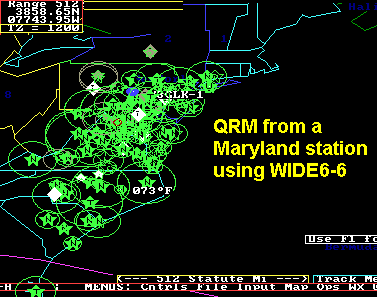
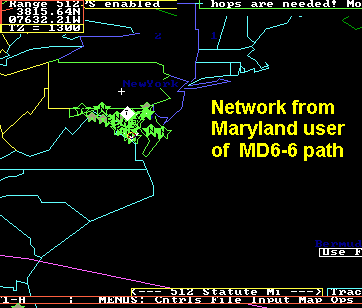
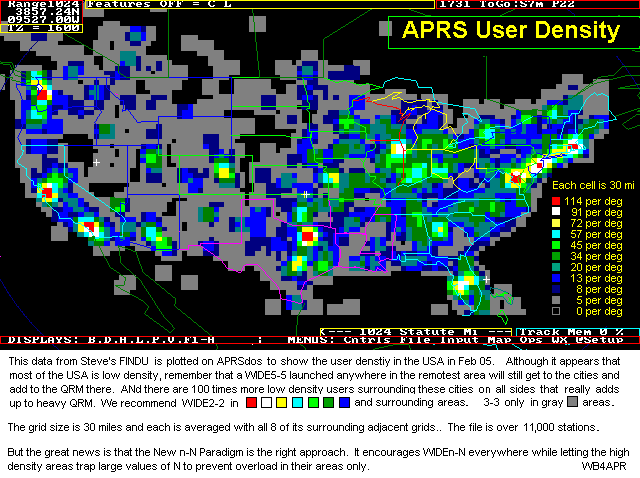
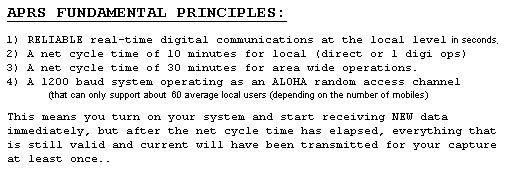
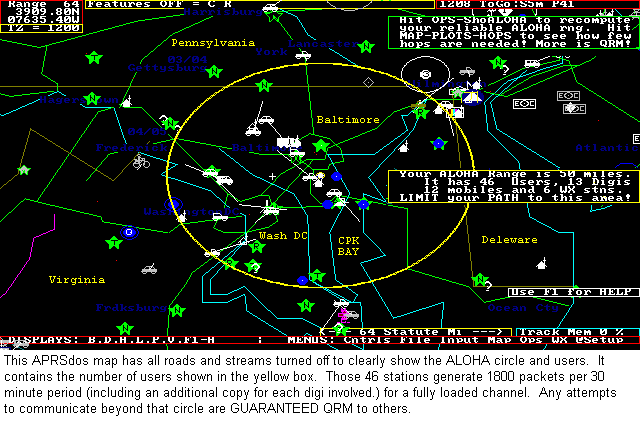
Since 14 Dec 2004..